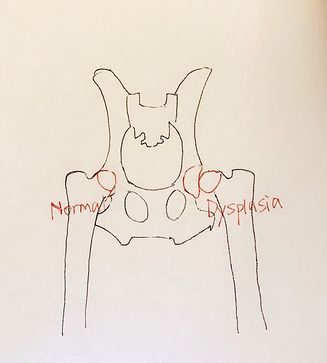Barlow and Ortolani Tests
This article is currently under review and may not be up to date. Please come back soon to see the finished work!
Description[edit | edit source]
The instability of the hip may be assessed by the Ortolani and Barlow tests, which play a big role in the clinical screening for developmental dysplasia of the hip [1]. The Barlow Test is a physical examination performed on infants to screen for developmental dysplasia of the hip. Barlow’s test identifies posterior sublimations or dislocation. It is named after Dr. Thomas Geoffrey Barlow, who devised this test. It was clinically tested during 1957–1962 at Hope Hospital, Salford, Lancashire [2].
The Ortolani Test was first described in 1936 by an Italian pediatrician Marino Ortolani; an outstanding pioneer in the early diagnosis and treatment of hip dysplasia. He describes it as a simple test that would establish a diagnosis of congenital dislocation of the hip in children one- year- old [3].
Technique[edit | edit source]
- Barlow Test
The Barlow test is a provocative maneuver used to reveal hip instability. The test is performed by standing at the end of the examination couch facing the baby. One hand stabilizes the pelvis whilst the other grasps the knee and flexes the hip to 90 °. The examiner’s fingers should lie over the greater trochanter with the thumb resting on the inner side of the thigh. A posterior force is applied through the femur as the thigh is gently adducted by 10-20 ° [4]. Mild pressure is then placed on the knee while directing the force posteriorly. The Barlow Test is considered positive if the hip can be popped out of the socket with this maneuver. The dislocation will be palpable [5].
2. Ortolani Test
In this test, the baby is placed in a supine position with flexed hips at 90 degrees. Index and long fingers of the examiner are kept laterally on the greater trochanter of the child and position the thumb medially near the groin crease. Stabilize the child’s pelvis is stabilized by holding the contralateral hip and using the opposite hand gently abducts the hip being tested by exerting an upward force simultaneously through the greater trochanter on the lateral side. The perception of a palpable clunk indicates a positive Ortolani test and along with this also represents the reduction of a dislocated hip into the acetabulum [6].
References[edit | edit source]
- ↑ Lotito FM, Rabbaglietti G, Notarantonio M. The ultrasonographic image of the infant hip affected by developmental dysplasia with a positive Ortolani's sign. Pediatric radiology. 2002 Jun;32(6):418-22.
- ↑ Barlow maneuver. Available from: https://en.wikipedia.org/wiki/Barlow_maneuver#cite_note-1 ( Accessed, 25/03/2021)
- ↑ Marino Ortolani. Available from: https://en.wikipedia.org/wiki/Marino_Ortolani (Accessed, 4/4/2021).
- ↑ Kumari P, Rani M. Developmental dysplasia of the hip. Ortho & Rheum Open Access. 2018;10:555794.
- ↑ Barlow & Ortolani Signs—DDH, Congenital Hip Dislocation. Available from: http://nabilebraheim.blogspot.com/2017/11/barlow-ortolani-signsddh-congenital-hip.html (Accessed, 5/4/2021).
- ↑ Kumari P, Rani M. Developmental dysplasia of the hip. Ortho & Rheum Open Access. 2018;10:555794.








